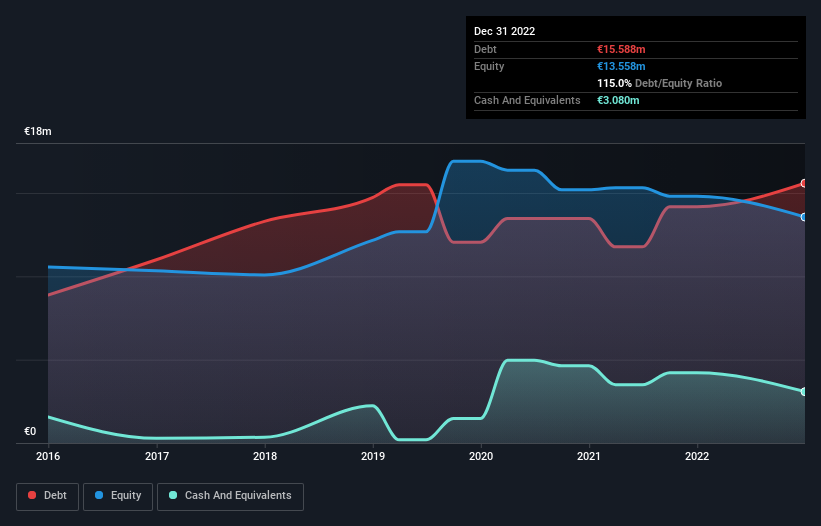Health Check: How Prudently Does Plásticos Compuestos (BME:KOM) Use Debt?
Howard Marks put it nicely when he said that, rather than worrying about share price volatility, 'The possibility of permanent loss is the risk I worry about... and every practical investor I know worries about.' When we think about how risky a company is, we always like to look at its use of debt, since debt overload can lead to ruin. We note that Plásticos Compuestos, S.A. (BME:KOM) does have debt on its balance sheet. But is this debt a concern to shareholders?
What Risk Does Debt Bring?
Debt is a tool to help businesses grow, but if a business is incapable of paying off its lenders, then it exists at their mercy. Ultimately, if the company can't fulfill its legal obligations to repay debt, shareholders could walk away with nothing. However, a more frequent (but still costly) occurrence is where a company must issue shares at bargain-basement prices, permanently diluting shareholders, just to shore up its balance sheet. Of course, debt can be an important tool in businesses, particularly capital heavy businesses. The first thing to do when considering how much debt a business uses is to look at its cash and debt together.
See our latest analysis for Plásticos Compuestos
What Is Plásticos Compuestos's Net Debt?
The image below, which you can click on for greater detail, shows that at December 2022 Plásticos Compuestos had debt of €15.6m, up from €14.2m in one year. On the flip side, it has €3.08m in cash leading to net debt of about €12.5m.

How Strong Is Plásticos Compuestos' Balance Sheet?
We can see from the most recent balance sheet that Plásticos Compuestos had liabilities of €12.0m falling due within a year, and liabilities of €12.6m due beyond that. Offsetting this, it had €3.08m in cash and €2.34m in receivables that were due within 12 months. So its liabilities outweigh the sum of its cash and (near-term) receivables by €19.2m.
The deficiency here weighs heavily on the €12.0m company itself, as if a child were struggling under the weight of an enormous back-pack full of books, his sports gear, and a trumpet. So we definitely think shareholders need to watch this one closely. After all, Plásticos Compuestos would likely require a major re-capitalisation if it had to pay its creditors today. There's no doubt that we learn most about debt from the balance sheet. But ultimately the future profitability of the business will decide if Plásticos Compuestos can strengthen its balance sheet over time. So if you're focused on the future you can check out this free report showing analyst profit forecasts.
In the last year Plásticos Compuestos had a loss before interest and tax, and actually shrunk its revenue by 13%, to €52m. We would much prefer see growth.
Caveat Emptor
Not only did Plásticos Compuestos's revenue slip over the last twelve months, but it also produced negative earnings before interest and tax (EBIT). Indeed, it lost €389k at the EBIT level. Considering that alongside the liabilities mentioned above make us nervous about the company. It would need to improve its operations quickly for us to be interested in it. For example, we would not want to see a repeat of last year's loss of €1.4m. In the meantime, we consider the stock to be risky. The balance sheet is clearly the area to focus on when you are analysing debt. However, not all investment risk resides within the balance sheet - far from it. We've identified 2 warning signs with Plásticos Compuestos , and understanding them should be part of your investment process.
When all is said and done, sometimes its easier to focus on companies that don't even need debt. Readers can access a list of growth stocks with zero net debt 100% free, right now.
New: Manage All Your Stock Portfolios in One Place
We've created the ultimate portfolio companion for stock investors, and it's free.
• Connect an unlimited number of Portfolios and see your total in one currency
• Be alerted to new Warning Signs or Risks via email or mobile
• Track the Fair Value of your stocks
Have feedback on this article? Concerned about the content? Get in touch with us directly. Alternatively, email editorial-team (at) simplywallst.com.
This article by Simply Wall St is general in nature. We provide commentary based on historical data and analyst forecasts only using an unbiased methodology and our articles are not intended to be financial advice. It does not constitute a recommendation to buy or sell any stock, and does not take account of your objectives, or your financial situation. We aim to bring you long-term focused analysis driven by fundamental data. Note that our analysis may not factor in the latest price-sensitive company announcements or qualitative material. Simply Wall St has no position in any stocks mentioned.
About BME:KOM
Plásticos Compuestos
Engages in the design, production, and marketing of mineral fillers, and color concentrates and additives for the plastics processing industry in Spain, Germany, France, and internationally.
High growth potential and good value.
Market Insights
Community Narratives



